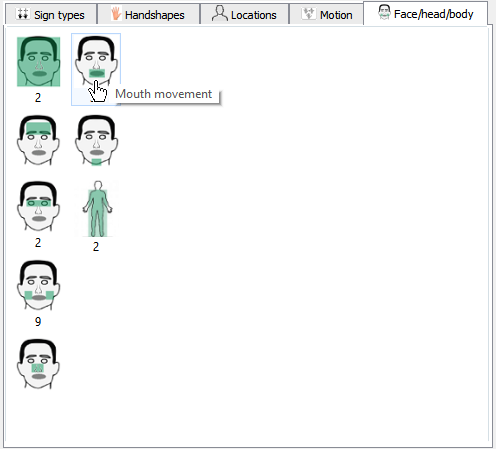Sometimes a sign uses a special facial expression. Maybe some part of the body (other than the hands) moves. We call these movements face/head/body. (People often call them non-manuals.) If a sign uses face/head/body movements, you can index it by the part of the face or body that moves. Then people can search for signs by those movements.
|
|
head moves: turns, tilts, nods, etc. |
|
|
eyebrows or forehead move: raised, lowered, furrowed, etc. |
|
|
eyes or eyelids move: look in a special direction, squint, wide open, etc. |
|
|
cheeks move: puffed, sunken, tongue in cheek, etc. |
|
|
nose moves: wrinkled, flared nostrils, side-to-side |
|
|
mouth moves: mouth open or shut; lips pursed, spread, smiling, frowning, sneering; tongue sticking out. We usually do not mark mouthing; we use this icon only for mouth movements that are not mouthing of spoken words. |
|
|
chin moves: side-to-side, up-and-down without opening mouth |
|
|
some other part of the body moves: shoulders, elbows, chest, belly, torso, legs |
Be sure you understand about face/head/body parameters before you try to index them.
To index a sign by face/head/body, first enter edit mode: click ![]() Edit sign in the toolbar. After you are in edit mode, if you see words instead of parameters, click
Edit sign in the toolbar. After you are in edit mode, if you see words instead of parameters, click ![]() Parameters in the toolbar.
Parameters in the toolbar.
Click the  tab.
tab.

If you can't see the face/head/body tab, use the scroll buttons on the right to scroll the tabs left and right. To see all the tabs at once, you can adjust the size of the window or the column.
You will see eight icons, for eight different parts of the face and body. You can hover the mouse over an icon to see a description. There are numbers under each body part. They show how many signs already use that body part.

Double-click the parameter for each body part that moves, or drag its icon to the indexing area. For example:
Sometimes a sign uses more than one of these body parts. If so, choose all the parts that move.
Some face/head/body movements are not parts of specific signs. For example, many movements of the eyes and forehead indicate questions or highlight what we are talking about. Sideways turns of the head and shoulders often indicate quotations or someone else's actions. These face/head/body movements are combined with signs when you put the signs in a sentence and they can be used with many different signs. We don't include these face/head/body movements in a dictionary. They are not part of the signs themselves, but they are added to signs by the grammar rules. So, we describe them in a grammar.
Other face/head/body movements are always present with a sign. They are part of the sign. We include these movements in a dictionary. We show them in the sign video and we index them with face/head/body parameters.
When we are indexing for face/head/body, we are interested in whether this part of the body moves. We are not interested in whether the hands touch this body part. If a hand touches a body part, index that with locations.
Mouth shapes and movements are special, because sign languages use the mouth for many things.
Many signs use the mouth to show spoken words, from a spoken language. We call this mouthing. Usually, we don't index a sign for mouthing. Mouthing is so common in some sign languages, it isn't useful for searching. We ignore it when we are indexing. We don't index these signs for a mouth movement.
Other signs use the mouth in other ways. The mouth movements do not come from a spoken language. We call these mouth gestures.
Some mouth gestures are really part of a sign. You can't make the sign without them. They don't add any special meaning, because they are always there. We include these mouth movements in the sign video, and we index them for a mouth movement.
Some mouth shapes and mouth movements can occur with many signs, and add a special meaning to them. For example, they might mean 'big', 'far', 'small', 'careless, sloppy', or 'amazing'. We call them mouth morphemes. They are a special kind of mouth gesture. You can choose how to handle them in your dictionary.
Created with the Personal Edition of HelpNDoc: Make Help Documentation a Breeze with a Help Authoring Tool